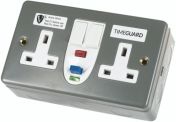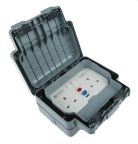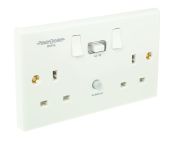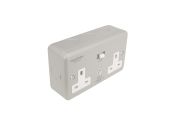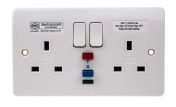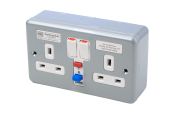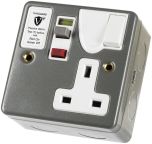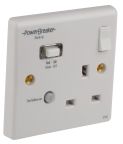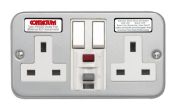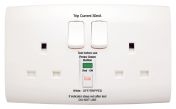RCD Sockets
RCD (residual current device) sockets are essential safety devices that protect against electrical shock and potential hazards in various settings. designed as protection against fatal electric shocks as they automatically switch off electricity when a fault occurs. This life-saving device protects against electrocution in instances where there is a bare wire, overheating or earth faults.
They provide an added layer of protection beyond standard sockets, making them crucial for enhancing electrical safety in homes, workplaces, and outdoor areas.
How RCD Power Sockets Work
These socket-outlets incorporate a built-in residual current device that constantly monitors the electrical current flowing through the socket. They can be used in place of a standard socket-outlet.
In normal conditions, the current flowing into and out of the circuit is balanced. However, if a fault occurs, such as someone touching a live wire or a faulty appliance leaking current, the RCD socket-outlet detects this imbalance and rapidly disconnects the power supply.
Different Types of RCD Sockets
Passive RCD Socket
Passive RCD sockets, also known as latching RCDs, offer a unique safety feature. Unlike active RCDs, which trip and disconnect the circuit in the event of both faults and power cuts, passive RCDs do not trip during power cuts.
This characteristic makes them ideal for use with appliances that need to remain powered even during a power cut, such as refrigerators, freezers, and critical equipment in remote or unmanned locations.
Active RCD Socket
Active RCDs, also known as non-latching RCDs, are the most common type of RCD socket. They trip out and isolate the circuit in the event of electrical faults and power cuts. This feature makes them suitable for applications where it is important to ensure that the circuit remains off until manually reset for machine safety, such as with power tools, garden equipment, and other rotating machinery.
Where Are RCD Sockets Used
- Bathrooms: In bathrooms, where the risk of electric shock is heightened due to the presence of water, RCD sockets provide crucial protection. They are typically required by electrical codes for sockets installed in bathrooms, such as for lighting, to minimise the risk of electrocution.
- Kitchens: Kitchens also present potential electrical hazards due to the presence of water and appliances that may come into contact with water. RCD-protected outlets offer an added layer of safety against electric shocks and potential fires in kitchens.
- Outdoor Areas: Weatherproof RCD sockets are specifically designed for outdoor use, providing protection against electrical shock in gardens, patios, and other outdoor spaces. They are typically resistant to moisture and dust, ensuring reliable operation in outdoor environments.
How to Choose the Right RCD Socket
When selecting RCD sockets, there are several factors to consider to ensure you choose the right type and specification for your needs:
- Number of poles: RCD sockets are available with different numbers of poles, typically ranging from one to four. The number of poles determines the number of circuits the RCD socket can protect. For example, a single-pole RCD socket protects one circuit, while a double-pole RCD socket protects two circuits.
- Current and voltage ratings: These ratings indicate the maximum current and voltage the RCD socket can safely carry. Choose a socket with ratings that match the requirements of the circuit you are protecting.
- Tripping current: The tripping current of an RCD socket is the current at which it will trip and disconnect the circuit. Choose a socket with a tripping current that is appropriate for the application and the level of protection required.
- Type of RCD: Consider whether you need a passive RCD socket (latching) or an active RCD socket (non-latching) depending on your application.
- Installation type: RCD sockets are available in various installation types, such as flush-mounted or surface-mounted, to suit various electrical setups and aesthetic preferences.
How to Install RCD Socket
Installing an RCD socket involves replacing an existing standard socket with the RCD protected socket. This typically requires isolating the power supply to the circuit, disconnecting the wires from the old socket, and connecting them to the corresponding terminals on the RCD socket.
It is crucial to ensure proper wiring connections and tighten the terminals securely to prevent loose connections or overheating. If you’re unsure, it’s advisable to seek the assistance of a qualified electrician to ensure electrical safety and compliance with electrical codes.
How to Order RCD Sockets from RS Hong Kong?
RS Hong Kong is a trusted supplier and distributor of RCD sockets, offering a wide selection of high-quality products from leading brands such as Powerbreaker, MK Electric, and Contactum. Our user-friendly online platform makes it easy to find the perfect RCD socket for your needs, with specifications and technical information available for each product.
Beyond RCD sockets, we also offer a comprehensive range of other electrical components and testing tools, such as multifunction electrical testers and ribbon cables, providing a one-stop shop for all your electrical needs.
Find the right device for your electrical needs on our website today!
How Delivery Works at RS Hong Kong
At RS Hong Kong, we understand the importance of timely delivery. That's why we offer flexible delivery options, including next-day and express delivery, to ensure you receive your products promptly and efficiently. To learn more about our delivery options and estimated delivery times, please visit our delivery information page.
15 Products showing for RCD Sockets
Related links
- Ribbon Cable
- MK Electric 30mA Passive Polycarbonate Switched Outdoor
- Powerbreaker PowerBreaker H 13A Passive Surface Mount No Outdoor Grey
- Plug Sockets
- MK Electric Masterseal plus 13A Active Polycarbonate IP66, Grey
- Timeguard Tripfast Passive Switched White
- Timeguard 13A Passive Steel Switched No Grey,
- MK Electric Masterseal plus 13A Active Polycarbonate Grey
